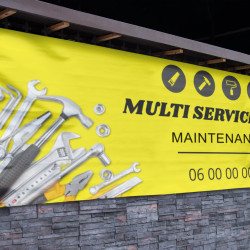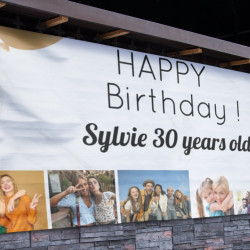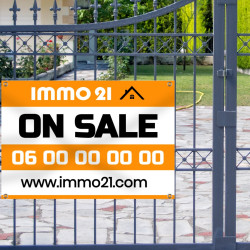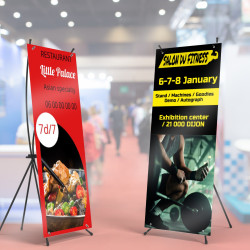Roll up advertising and kakemono

delivery at 4,90 € estimated on 12/18
Configure productA roll-up is a visual means of communication that has become extremely popular in the signage sector. It's also known as a kakemono, a roll-up advertising banner that can be used to promote a company, product or service. Roll-ups play an essential role in your communication while on the move.
Your personalized Roll up kakemono: effective signage for your communication.
What is a roll-up?
A roll-up is a visual means of communication that has become extremely popular in the signage sector. Also known as a kakemono, it's a roll-up advertising banner that can be used to promote a company, product or service. Professional events such as trade shows, fairs and conferences often call for roll-ups.
The roll-up consists of an aluminum casing and a roll-up banner that attaches to a telescopic pole. Lightweight and compact, they are easy to transport. Dimensions vary according to the user's requirements, but the height of a roll-up is generally around 2 meters.
A roll-up has many advantages. It's extremely easy to set up and dismantle, making it ideal for one-off use. What's more, it's easy to store and transport, as it comes with a practical carry bag.
A roll-up is a highly effective and professional way of communicating about a product, service or company. It's a portable, practical signage solution that can be used repeatedly for different events.
What benefits does a roll-up offer?
The roll-up is a highly effective visual communication medium that offers multiple communication benefits. First and foremost, it attracts the attention of passers-by thanks to its imposing size and attractive design. In this way, it stands out from other advertising media.
What's more, the roll-up is a versatile means of communication that can be used in a variety of environments, whether at a trade show, an exhibition, a conference or even in a store. It offers an effective, targeted way of communicating about a product, a service or a company.
Roll-ups are also extremely easy to use and set up. It requires no special technical skills, and can be assembled in just a few minutes. What's more, its practical storage case makes it easy to transport, making it perfect for use on the move.
Finally, the roll-up is a cost-effective means of communication that offers exceptional value for money. It can be reused and used over and over again, reducing long-term communication costs.
In short, the roll-up is a practical, economical and effective way of communicating visually, offering numerous communication benefits. It promotes distinction, targeted communication and lower long-term communication costs.
How do you choose your kakemono?
Choosing the right kakemono can be a real challenge. There are so many different options on the market, it can be hard to decide where to start. Here are a few tips to make your kakemono selection easier.
First and foremost, take the time to consider the purpose of your roll-up. Is it for indoor or outdoor use? Is it for a specific occasion or for long-term use? You can identify the type of kakemono you need by answering these questions.
Next, consider the size of your roll. It needs to be big enough to be visible from a distance, but not so big that it takes up all the space. It's vital to consider the space available for your kakemono in order to select the right size.
Next, consider the design of your rollup. It's essential that it's clear, understandable and captivating. Careful selection of colors, images and text is essential to ensure optimum comprehension of your message.
Finally, consider the support for your roll-up kakemono. Various supports can be used, such as tripods, X-frames and wall brackets. Select a tool suited to your particular needs.
In summary, selecting the right kakemono involves taking into account the purpose, size, design and support. By following these recommendations, you'll be able to find the ideal kakemono to promote your company, product or service effectively and with quality.
What type of signage should you choose?
Directional signs, promotional posters, product labels, orientation signs , etc., can be used for indoor signage .
Illuminated signs, banners, billboards, electronic displays, etc., can be used for outdoor signage.
Vehicle branding with your company name and logo, contact information, advertising, etc., can be included in vehicle signage.
Event signage can include signs, exhibition stands, temporary event labels, and so on.
Safety signage can include signs for areas of concern, safety instructions, evacuation plans, and so on.
Window signs, product labels, promotional posters, customer orientation signs, etc., can be used for store signage.
Office signage can include signs for meeting rooms, orientation signs for visitors, labels for office supplies, and many more.
It's crucial to select the signage model that best suits your business and your requirements. You can enlist the help of an expert to design and install the signage that best suits your business.
What's the difference between a roll-up and a kakemono?
You may have heard of the terms “roll-up” and “kakemono” if you're looking for visual communication media for your company. Despite their similarity at first glance, there are significant differences between the two. In this text, we will analyze these disparities and assist you in choosing the medium that best meets your requirements.
The Roll Up:
The Roll Up is a vertical communication device, often used to display large images. The visual is printed on a PVC or fabric panel that is rolled up in a metal case. The Roll Up is easy to install and transport, making it a popular option for trade fairs, exhibitions and commercial presentations.
Kakemono:
The Kakemono is also a vertical means of communication, but it differs from the Roll Up in several ways. The printed canvas of the Kakemono is attached to an aluminum, wooden or plastic frame. Unlike the Roll Up, the Kakemono does not fold into a case, which makes it a little heavier to transport. Nevertheless, it offers greater flexibility in terms of size and shape, and can be used to design customized visuals.
Distinctions between Roll Up and Kakemono :
The Roll Up and the Kakemono are distinguished primarily by the medium used to display the visual. The Roll Up is made up of a PVC or fabric panel rolled up in a metal case, while the Kakemono is made up of a printed canvas attached to an aluminum, wood or plastic frame. The Roll Up is simpler to transport and install, while the Kakemono offers greater flexibility in terms of size and shape.
In short, if you're looking for a practical means of communication to transport and install for a sales presentation or exhibition, the Roll Up is undoubtedly the wisest solution.
If you're looking for a more flexible medium that offers a greater diversity of sizes and shapes for your visual, the Kakemono is undoubtedly the ideal solution. Whatever you decide, make sure you select a high-quality visual to grab your audience's attention and effectively communicate your message.
How can a roll-up be used?
- Roll-ups are an effective way of attracting visitors' attention to your stand and presenting your company and products clearly and concisely at trade shows.
- At promotional events, you can use a roll-up to promote special offers, discounts or new products at open days or trade fairs.
- Roll-ups can be used at conferences and seminars to present information about your company or products, or to direct participants to the conference room or exhibition areas.
- A roll-up can be used to promote your company or products at sporting or cultural events, such as concerts or sports tournaments.
- A roll-up can be used to convey essential information about your company in situations such as company meetings, training seminars or corporate celebrations.
- A roll-up can be used in stores and shopping malls to promote special offers or new products, or to direct customers to a specific area of the store.
In short, the roll-up is a versatile means of communication that can be used in a variety of situations to present your company and products professionally and effectively.
How do you design a kakemono for your company?
Before you start designing your kakemono, it's important to determine its purpose. Is it to win the loyalty of new customers, promote a new product or increase your company's visibility ?
Select format and size: kakemono can be produced in a variety of formats and sizes, depending on your purpose and where it will be displayed. The space available for display must be taken into account.
Create your visual design: creating your visual design is an essential step. It must be explicit, understandable and captivating. Opt for vibrant hues and high-quality images to grab the attention of your target audience.
Include your logo and contact details: Be sure to include your logo and contact details in your kakemono. This will facilitate communication between individuals if they are interested in your products or services.
It's important to use concise, clear text for your kakemono, so that people can read it easily. Use easily legible fonts and short sentences to effectively convey your message.
Please print your kakemono once you've finished designing it. Be sure to select a high-quality printing supplier to achieve optimum results.
Install your kakemono: finally, place it where it will be displayed. Make sure your message is clearly visible, and that the lighting is just right to make it stand out.









